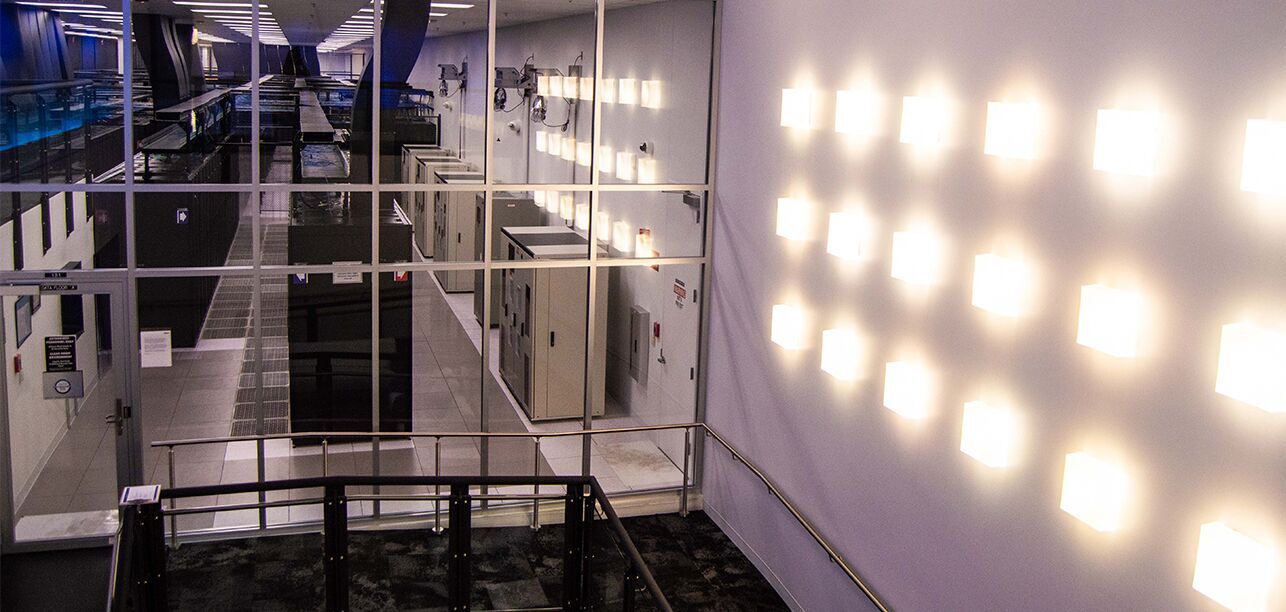Month: June 2018

Q&A: Expanding on a Live Data Center With Executive Construction Inc.
INAP recently completed the expansion of our Dallas data center, one of our flagship facilities. The Tier 3-type facility now has over 30,000 square feet of data center white space and 6 megawatts of power. We partnered with Executive Construction Inc. for the build, and they were also a key sponsor for the grand opening event. I sat down with Rob Daly, Vice President and Director of Field Operations, to discuss the ins and outs of mission-critical builds, the unique challenges of expanding on a live data center and why finding the right partner makes all the difference.
Ryan: Executive Construction recently partnered with INAP on the expansion of our flagship data center in Dallas, and we celebrated the grand opening together in May. At a high level, how did this expansion project go?
Rob: It went very smoothly—there was nothing unexpected. From a constructability and availability of equipment standpoint, everything fell into place nicely. Despite some of the equipment lead times being extended, we collaborated as a team to creatively come up with a different approach for certain installations to still deliver the project on-time.
From your perspective, what are some of the features of this data center that will stand out to prospective tenants?
First, your staff there is extremely knowledgeable. They’re available and at the ready for any of your customers that come in there. You see that interaction daily. Second, the site is extremely clean. And third, of course, the security of your site is also important. That’s a big thing that a lot of customers are super sensitive about: the security of their information.
As a well-designed Tier 3-type facility with N+1 requirements, I think the greatest feature of the Dallas site is that there’s room for expansion, so your customers can also grow. To know that the facility has space potential beyond what’s actually there right now is important. Customers that are either experiencing rapid growth—or strategically planning for it in the coming years—don’t want to have to put cabinets in another data center two miles down the road. They want the ease and convenience of one facility. Having the ability to grow with INAP is a big differentiator.
For those who may not be familiar with your industry and line of work, could you define what constitutes a mission-critical project? And what are some of the biggest challenges associated with something like data center construction?
That’s any project where 24/7/365 business continuity is vital to the organization and the customers they host. With a Tier 3-type data center, customers expect limited to no impact maintenance with zero downtime so their services are never interrupted.
In terms of challenges, speed-to-market is often the most important factor in facility construction, so these are always fast-paced projects. Typically, our colocation data center partners have potential tenants under contract that are anxious for the space. This means the sooner we get the facility up and running, the sooner our clients capture revenue. We push hard to deliver ahead of schedule for that reason but also because we know that our clients have clients of their own, and we want to support their customer service expectations.
The other aspect we carefully plan for is equipment coordination. Often, the data center company decides to purchase the equipment themselves. However, equipment is such a critical component of any build that we help manage that process with the owner. We align purchasing lead-times—particularly of long-lead items like chillers or generators—with our construction schedule to ensure all stakeholders are on the same page about the equipment specs ordered and when specific pieces need to arrive on-site. We’ve had the most success with identifying the key milestone dates and then proactively connecting on a regular basis with manufacturers on equipment status to avoid any impact on the sequence of work.
Our Dallas facility is a live site, meaning the expansion couldn’t interrupt the normal operations of the data center. With projects like this, what are the extra considerations you have to take?
One of the valuable things about partnering with us is that when we’re doing your builds, we’re always focused on serving you and your customers. Taking logistics and sequence of work into account, we want to make sure we don’t paint ourselves into a corner.
We need to make it safe and feasible for us to go back in and continue downstream expansions without impacting current customers. When it’s an existing, live data center, it’s a clean room free from dust and other contaminants. We go through an extensive method of procedure (MOP) process for every critical activity. Even activities that most would define as non-critical, we prefer to treat them as critical. Our team wants to make sure we follow the right processes to eliminate any risk whatsoever.
Throughout the MOP process, we identify every single step, even the most minor details, like what tools we’ll use when working on specific switch gear, and then do a tool count. There’s also a pre-huddle meeting with every on-site team member. We go through the process, execute it and at the completion of the MOP, we go through it to make sure we’ve checked all the boxes, that everything was done, and the activity is complete.
When it comes to data center builds, what trends do you think will define this kind of project over the next decade? And what kind of challenges will persist?
There’s definitely a lot of growth in the data center space right now—it’s a booming market. More and more, people are entrusting their data management to professional firms like INAP because managing their own data centers is no longer a viable capital investment. One, it’s added real estate that now they can’t use for office space or other uses; and two, if they maintain data on-site, they’ve got to hire and retain the appropriate staff to manage that data center and keep it up and running. And with demand for cloud growing the way it is, the easy addition of managed cloud services and cloud connectivity to colo services only adds to the appeal.
But real estate must also factor in the equipment. There’s so much equipment required to be a Tier 3-type facility, since you have your N+1 or 2N requirements. For redundancy purposes, you double up on equipment, which makes the footprint and the cost that goes along with it a lot larger. And of course, a data center requires significant mechanical and electrical infrastructure, which is costly to purchase, maintain and eventually replace. In the 20-plus years we’ve been building mission-critical facilities throughout the country, we have seen a continued increase in the number of companies that opt to push those services to colocation facilities, which makes a lot of sense. It’s going to continue to boom.
At INAP, we take a lot of pride in selecting partners that share our devotion to performance and reliability. From Executive Construction’s perspective, when meeting with a new prospect, what sets your company apart in terms of data center builds or mission-critical builds in general?
We’re not looking to be a one-and-done contractor. With each engagement, we work to create a trusting, lasting partnership. It’s one of the aspects of our relationship with the INAP team that I’ve personally valued the most. Whether we’re in contract negotiations, providing conceptual budget assistance to vet building sites, or in the middle of a build’s hectic final week, we take our role as our client’s partner seriously. We like to prove that collaboration is in our DNA, so we work hard to ensure any decision or outcome makes sense for all parties involved. We also pride ourselves on our integrity—doing what we say we’re going to do.
We’ve seen success in the construction industry by focusing on reputation and relationships. A number of mission-critical clients have brought us with them across the country. These partners have a national reach and in different geographic markets, they say to us, “You’re a trusted partner, and we’ve got a new opportunity—come with us.” Maybe our role isn’t general contractor; maybe we’re serving as their advocate to make sure the right contractors are on board and holding them to the same standard we hold ourselves to, and that our clients have gotten used to. I think the fact our clients and design partners see us in that way speaks volumes.
Explore HorizonIQ
Bare Metal
LEARN MORE
Stay Connected

Yankees or Red Sox, Linux or Windows, Star Wars or Star Trek: There’s no shortage of choices life asks us to make. When it comes to cloud versus colocation, it may be tempting to see it as just another either-or decision. But the question you should be asking isn’t “colo or cloud”—it’s “what’s the right mix for my applications?”
Colo is sometimes forgotten because of its more popular, younger and shinier cousin the cloud, but there are use cases for both, and your particular mix will depend on your applications. For example, a financial services company that wants to leverage cloud to gain cost efficiency might use a public cloud for its end-of-day or end-of-month batch processing, while also using colo or hosted private cloud for its mission-critical databases and supporting applications. This configuration would provide the cost efficiency of public cloud for short-term workloads while also utilizing a dedicated, secure platform optimized for applications that are always on.
Regardless of your situation, developing a comprehensive cloud strategy will help you avoid lock-in, providing flexibility, adaptability and room to grow as your needs evolve. And that multicloud strategy just might include some smart usage of colocation if, for example, you have a need for specific hardware or want a network presence in certain locations. Here’s a primer for understanding the big pieces of cloud, colo and anything in between.
The Hidden Cost of On-Premise Solutions
For any organization facing the decision to “build” or “buy” their infrastructure, “buying”—whether bringing your hardware and renting space in a colo facility or shifting entirely to the cloud—is a simple step that is guaranteed to level up your IT. Yet the conversation about colo and cloud is usually focused on dollars spent and saved. This is understandable, especially since on-premise data centers are often expensive to secure and maintain, and going off-premise can have a clear impact on cost savings. But what could the conversation be if CAPEX or OPEX weren’t the primary drivers of your IT infrastructure decisions?
Now don’t get me wrong—I know keeping costs reasonable is important—but I also think it might be helpful to think about your choice in terms of a different resource: time. The math is simple: If you can offload certain tasks to a service provider, that’s time you get back. Every minute not spent handling maintenance and administration is a minute you now have free to focus on your actual applications. With that being said, here are the ways colo and cloud can make your life better.
Security and Compliance Improvement with Cloud and Colo
With a colo or cloud service provider, all the work of physical data center security and maintenance is no longer part of your to-do list—and a lot of compliance too, depending on your provider. With a managed service provider, they can take care of your routine data security and compliance tasks or even help you architect your infrastructure to fit the specific compliance needs of your applications.
Connectivity Ease with Colo and Cloud
A big part of the decision to move off-premise may be a simple need for connectivity. Your on-premise solution might lack certain connectivity altogether or you may have trouble with reliability or latency. Colo can solve these issues, whether you need to connect to certain geographies, carriers or third-party clouds like AWS or Azure. Managed services from your provider can give you an edge here too, ensuring dependable connectivity and minimizing latency even in spread-out networks.
Colo and Cloud Backup and Disaster Recovery
A huge upside to partnering with a comprehensive service provider is that regardless of your infrastructure solution, backup and disaster recovery services can be easily implemented. Whether using a colo facility or a hosted private cloud, both are effective, efficient ways to build redundancy into your systems—without having to build and operate your own second site.
The Biggest Difference-Maker: A Trusted Service Provider for Cloud and Colo
When choosing the right colo or cloud mix, it’s a good idea to start by asking a few questions:
- Where do you see your IT infrastructure and operations strategy in three to five years?
- What do you predict your service needs will be then?
- And most importantly: Are you working with a provider that gives you the capability to do the things you need to do today and won’t hinder you from doing what you need to do in the future?
Choosing the right colo or cloud provider can determine whether you have the flexibility and freedom to meet your future needs. They can be an invaluable partner in helping you to rightsize for today without limiting your options for the future. So pick a cloud or colo provider with a wide range of infrastructure solutions and managed services and one that is skilled, knowledgeable and experienced in multiple competencies, whether colo or cloud. At INAP, my team of solutions engineers help customers navigate the process, identify hard-to-spot downsides and share knowledge based on our experience assisting other customers.
Applications that aren’t a good fit for a legacy infrastructure model can be easily migrated with the help of a service provider like INAP, while maintaining a single partner that knows you and your business. The right cloud or colo solution will depend on your applications, and that will inevitably evolve over time. Rather than pitting colo against cloud, start from what your applications require, then find the right mix that makes sense for you.
Explore HorizonIQ
Bare Metal
LEARN MORE
Stay Connected

By the numbers, the IT skills gap seems easy to understand. According to the Bureau of Labor Statistics, there will be nearly 4.8 million computer-related positions by 2026, a steady increase of 13 percent over 2016.1 Add in the fact that only about 60,000 people are graduating in the U.S. each year with a computer-related bachelor’s degree of any kind, and it’s no wonder why there’s so much talk about the IT skills gap.2
But it’s not just about a lack of people. Companies and individual employees alike are being constantly bombarded by the ever-increasing pace of technological development, making the task of playing catch-up a constant challenge for IT professionals at any level. In a 2017 survey by CompTIA, there was near consensus among respondents about the IT skills gap, with two top concerns: 1) Too many workers lack advanced skills, and 2) segments of workers are falling behind.3
Part of the solution to the IT skills gap may lie in educational institutions updating their curricula more quickly to match the pace at which technology is evolving. In the meantime, there are things both companies and IT professionals can do to help bridge the IT skills gap.
What can IT professionals do to set themselves up for success in the IT industry?
Think outside your IT job title
IT is moving at a fast pace. Case in point: Amazon Web Services released 497 new services and features in the last quarter of 2017 alone.4 Companies need professionals well-versed in these kinds of skills and able to keep up as they quickly evolve. There currently aren’t enough, and the data shows that competition is fierce: Of the top 15 highest-paying IT certifications in 2018, five are for the AWS platform. These five certifications all earn above-market rates, with the average salary being a little more than $125,000.
At the same time, organizations are increasingly expecting IT to be a trusted, strategic partner to the rest of the business. These two seemingly opposing trends mean that IT professionals are best positioned when they have both specialized, in-demand skills as well as generalist chops. The latter is not merely for executives or managers; at any level, IT professionals seeking an edge should be looking for ways to align IT’s day-to-day practices, systems and processes with the entire company’s strategic goals.
Take ownership of your own career path
In an ideal world, we would all know exactly the skills and knowledge that will be most in-demand now and forever. Here in reality, you must be and should be the person most invested in your own career growth and training. Take an active role in trendspotting and researching what will be most useful for you in your field and specialty. If you work for a company that provides a development budget and opportunities to learn new skills or technologies, use them! If not, budget the time and money to invest in yourself. Or if you are currently looking for new opportunities, explore what certifications and trainings will help you signal to potential employers that you are being proactive and doing what it takes to stay ahead of the game.
What can companies do to meet the IT skills gap head on?
Develop a plan to identify and address your IT skills gap
At the risk of stating the obvious: Any organization that doesn’t know its own talent and skill needs cannot expect jobseekers to know either. Yet among respondents to CompTIA’s survey, only one in three organizations had a formal strategy to address their IT skills gap; the rest had either an informal strategy or none at all.5 But no matter where your organization is or what it needs, it’s never a bad idea to start with the basics. A key part of this process should be keeping track of the going rate for new IT skills. Where supply and demand meet for the hottest skills may not work with your budget, so consider your options, whether hiring, outsourcing or finding another way to gain the capability.
Remember that one size doesn’t fit all
Many companies have development budgets and allowances for employees to keep current with trends and learn new skills. Employers can use these to both reward motivated talent and incentivize continued learning, chipping away at the skills gap in the process. But keep in mind that people have different ways that they learn best, whether through traditional classes, independent study or hands-on workshops, so a little flexibility can go a long way.
Extend your team with a service provider
Even for organizations with robust strategies for meeting their particular IT talent needs, it can be difficult to stay on top of it all. Partnering with a trusted IT service provider can bring you the capabilities, knowledge and experience you need but wouldn’t necessarily be able to acquire through hiring or professional development without great cost and effort. For instance, organizations dipping their toes into the cloud for the first time may not want to invest in net new head count or certification training. Yet they still need their hyperscale, multi-tenant cloud environments to be deployed and managed without a hitch. Enter Managed AWS and Managed Azure service providers, who can act as an extension of your team, ensuring all your environments are optimized for the needs of the workload.
Patience, patience, patience
Whether you’re an organization trying to meet seemingly ever-shifting talent needs or an IT professional just looking to get a leg up on the competition, being patient is just as important as being proactive. Aligning budgets and resources takes time—even when everyone is on the same page—and so does learning new skills, even if you know which ones to focus on. No one company or individual can “solve” the IT skills gap, but there are things both can start doing today that will make a tangible difference in the future.
Links
1. Bureau of Labor Statistics. “Occupational projections and worker characteristics,” Retrieved May 2018.
2. National Center for Education Statistics. “Bachelor’s degrees conferred by postsecondary institutions, by field of study,” Retrieved May 2018.
3. CompTIA. “Assessing the IT Skills Gap,” May 2017.
4. ARN. “AWS released 497 new services and features last quarter,” February 2018.
5. See note 3.








